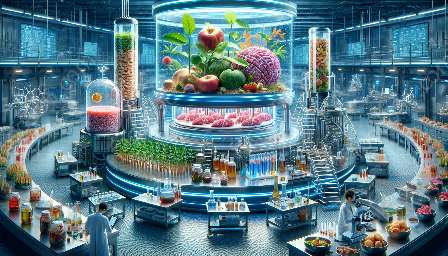In the world of food preservation, microbial and enzymatic fermentation plays a crucial role in maintaining the quality, safety, and flavors of various food products. This dynamic process has significant relevance to both fermentation processes in food preservation and food biotechnology, offering a sustainable and effective means of enhancing food shelf-life and nutritional value.
The Fundamentals of Microbial and Enzymatic Fermentation
Microbial and enzymatic fermentation involves the use of microorganisms and enzymes to transform food substrates, resulting in desirable changes in the characteristics of the food. This natural process has been utilized by human civilizations for centuries, enabling the preservation of perishable food items and the creation of diverse culinary delights.
Microorganisms in Fermentation
Microbial fermentation relies on the metabolic activities of bacteria, yeast, and molds, which convert carbohydrates, proteins, and lipids into compounds such as organic acids, alcohols, and flavor-enhancing molecules. These microorganisms play pivotal roles in various food preservation techniques, including the production of fermented dairy products, pickles, and fermented meats.
Enzymes in Fermentation
Enzymatic fermentation involves the use of specific enzymes to catalyze biochemical reactions, leading to the breakdown of complex food components and the development of unique flavors and textures. Enzymes such as amylases, proteases, and lipases are harnessed to improve the sensory attributes and extend the shelf-life of numerous food products, ranging from baked goods to beverages.
The Role of Fermentation in Food Preservation
Fermentation serves as a natural method of food preservation, effectively inhibiting the growth of harmful microorganisms while enhancing the nutritional value and digestibility of foods. Through the process of acidification, the production of antimicrobial peptides, and the reduction of anti-nutritional factors, microbial and enzymatic fermentation contributes to the safety and longevity of various food items.
Food Safety and Quality
The fermentation of foods leads to the generation of organic acids, such as lactic acid and acetic acid, which lower the pH of the products and create an inhospitable environment for pathogenic bacteria. Consequently, fermented foods exhibit improved safety and a reduced risk of spoilage, ensuring that consumers can enjoy wholesome and microbiologically-stable food options.
Nutritional Enhancement
During fermentation, microorganisms and enzymes break down complex nutrients, release bioactive compounds, and increase the bioavailability of essential nutrients. This transformation results in improved digestibility, increased levels of certain vitamins and minerals, and the creation of functional compounds with potential health benefits, aligning with the principles of food biotechnology and promoting consumer wellness.
Applications and Innovations in Fermentation Processes
The application of microbial and enzymatic fermentation in food preservation continues to advance, driven by technological innovations and consumer demand for natural, minimally processed foods. From traditional fermentations to modern biotechnological approaches, the diverse range of techniques and products derived from fermentation showcases its adaptability and versatility in meeting contemporary food industry needs.
Traditional Fermented Foods
Across different cultures and regions, traditional fermented foods reflect the rich diversity of culinary heritage and fermentation practices. Products such as kimchi, sauerkraut, tempeh, and kefir exemplify the artistry and tradition of microbial and enzymatic fermentation, captivating both food enthusiasts and researchers alike with their cultural significance and sensory pleasures.
Biotechnological Advancements
Advancements in food biotechnology have revolutionized fermentation processes, enabling the targeted use of starter cultures, genetically engineered microorganisms, and immobilized enzymes to enhance the efficiency and consistency of fermentations. These developments have paved the way for novel functional foods, precision fermentation, and the sustainable production of value-added ingredients, aligning with the contemporary principles of food biotechnology and meeting the demands of an ever-evolving market.
The Future of Microbial and Enzymatic Fermentation
As global interest in sustainable food practices and natural preservation methods continues to grow, the future of microbial and enzymatic fermentation appears promising and vibrant. With ongoing research, interdisciplinary collaborations, and a renewed appreciation for traditional knowledge, fermentation processes are poised to contribute significantly to the innovative landscape of food preservation and biotechnology, offering solutions that resonate with modern consumer preferences and environmental consciousness.
In conclusion, the multifaceted realm of microbial and enzymatic fermentation in food preservation extends far beyond mere preservation, enriching the sensory experiences, nutritional value, and ecosystem sustainability of the foods we enjoy. By exploring the intricacies of this captivating field, we can gain valuable insights into the intersections of traditional wisdom, scientific advancements, and the enduring power of nature in shaping the future of food.

